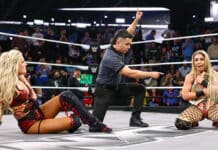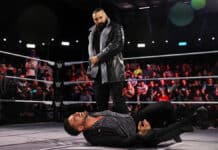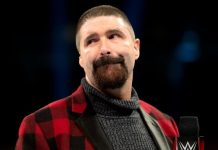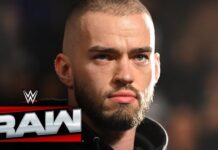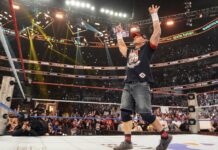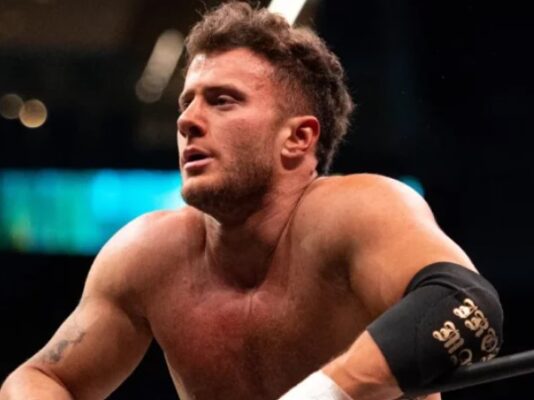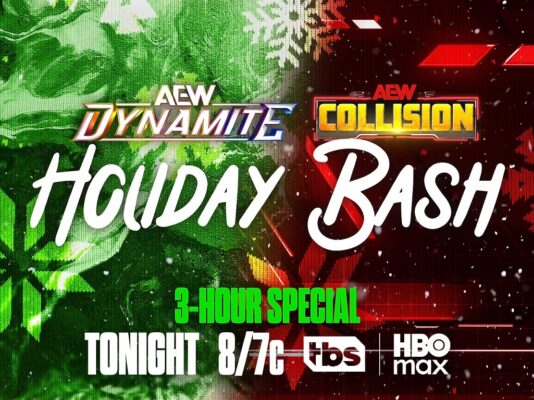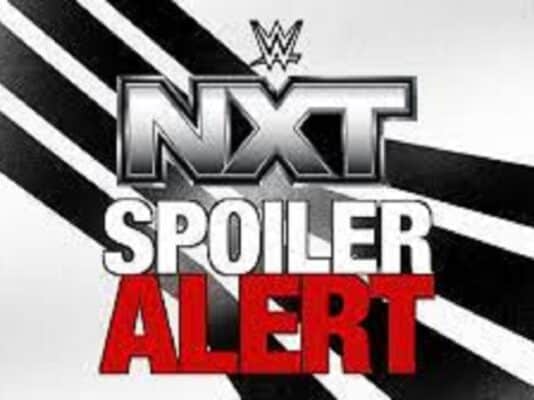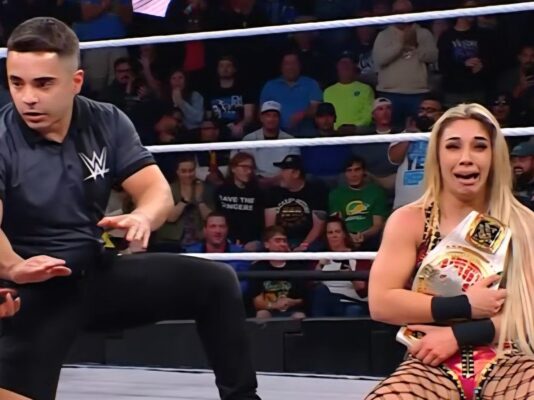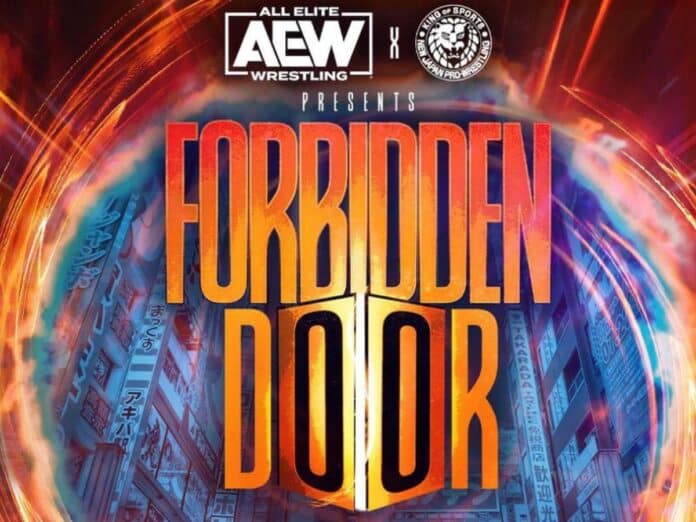
The Forbidden Door pay-per-view, a co-promoted venture between All Elite Wrestling and New Japan Pro Wrestling is in the books, and it looks like the results of the event might give an indication of the direction the company will go ahead of the Wembley Stadium event in August.
As is the case with any PPV event, the primary questions are, did the show live up to the hype and was it worth the price tag to order the broadcast?
The show opened with the AEW world title match, with MJF defending against NJPW legend, Hiroshi Tanahashi. If I had to guess, I’d say that this was put first on the card to specifically protect Tanahashi, who has definitely slowed down in recent years after a myriad of injuries that he suffered during the several years that he carried New Japan took their toll. Make no mistake about it, “The Ace” of the Japanese league is without question an all-time great, but he undoubtedly shows his age in his current work. At 46, Tanahashi has achieved that legendary status that just being on the card in Japan is seen as a major deal, similar to when John Cena makes an occasional comeback to the ring, but Tanahashi doesn’t necessarily have that type of cache with American fans because those audiences, both at home and in the building might not be as familiar with his work. Granted, he’s a very smart worker that does all the little things that make the most of his performance, but his well-documented series of knee injuries seemed to noticeably limit his mobility.
That being said, the pace of the AEW world title match was lumbering, even if it was designed to camouflage some of the aging legend’s mobility issues. The bout started with a lot of pandering to the crowd and some stalling by MJF before there was a series of holds that kept the action at an almost tedious pace. Even during Tanahashi’s offense in the contest, including a rather clunky cross body and a few sling blade maneuvers that didn’t get much height, he looked his age. The over-the-top knee injury sell from MJF happens in almost every match so it almost seems comical rather than anything that could add depth to the match. Tanahashi got a pin while the referee was distracted, which gives him a reason for the defeat after MJF used the diamond ring to get the victory. The match itself was fine, but nothing spectacular so I’m not sure if the win does anything to boost MJF’s title reign.
CM Punk vs. Satoshi Kojima was in a similar boat, as far as it was a current AEW star against an aging Japanese legend with a very predictable finish. Let’s be honest here, nobody thought that Kojima was going to make the trip back to the United States to compete in the next round of the Owen Hart tournament, and this contest was only booked as a way to get CM Punk on the show, but considering that this bout had no build up or barely any promotional push before the event, I don’t think his involvement made much of a difference either way. However, Kojima can still go, despite being 52, and Punk worked to the Japanese grappler’s strength to make him look good in the ring. The match itself wasn’t anything too spectacular, but it was decent, and highlighted the best stuff that Kojima does at this point in his career. There was an entertaining Easter egg for longtime ROH fans, as Punk yelling “Kojima!” and “lariat!” in the corner was an inside joke to a story he told in an ROH shoot interview when he prank called former ROH booker, Gabe Sapolsky, pretending to be Homicide with claims that he had to cancel a match with Kojima in 2003.
As mentioned, the finish was predictable so the bigger story is the negative reaction that Punk received on Collision and at the pay-per-view in Toronto. Keep in mind, the diehard audience that primarily follows All Elite are the fans of the performers that were a part of the launch of the organization, and considering how much Punk trashed the company before he returned, it’s possible that the hostile reaction will continue for the majority of the audience. Usually, that could set the stage for a major heel run, but all indications are that The Elite aren’t willing to work with Punk, which is foolish since that’s the biggest money to be made for the company. Phil Brooks might be a jerk, but he’s a talented jerk and does his best work as a heel anyway so if The Elite are serious about building the future of AEW as a profitable business then they should be the professionals they claim to be and draw the biggest money possible for the company.
The four-way match for the International title had a lot of action, but it was more just a series of spots than a contest that had any structure to it. Again, there wasn’t anything wrong with this match, but I think there could’ve been a better quality match with a traditional title match between Orange Cassidy and any of the challengers. I understand that Tony Khan tries to shoehorn as many performers on the card as possible, but when there are a few different multi-person matches on the card, it’s an aspect of overbooking that can be a tedious viewing experience.
Sanada vs. Jungle Boy was a really good bout that went about ten minutes, and it should be a booking lesson for Tony, not every match needs to be twenty minutes to be a good match. This was a solid under card bout that provided quality to the card so it was mission accomplished. Furthermore, this was an example that Jack Perry can elevate his game when he brings a level of intensity to his work, as opposed to promos where he sounds like a total mope or when he gets steamrolled in the ring by Rush on Dynamite. Hopefully, the heel turn can be an opportunity for Jack Perry to add that intensity to his character. After the infamous wrestling convention Q&A clips from England a few months ago, Perry has the chance to be a believable heel so it will be interesting to see if he can make progress in the next few months.
The 10-man tag was the opposite of the International title match, in terms of the structure and pace that it had that allowed for a contest that was action packed, but was more than just a spot fest. The chop exchange between Eddie Kingston and Jon Moxley was very well done because while the sequence is usually just two wrestlers standing there waiting for the next strike, Kingston and Moxley showed how the exchange can be done right with proper selling and physicality. The biggest takeaway from this segment might be that Konosuke Takeshita should be a priority to become a main event star within the next year or so. He took the company by storm with stellar performances when he debuted, but was lost in the shuffle after that because of the very bloated roster. That said, this heel turn proved just how much of a complete worker that he is since he also has the mannerisms and body language of a heel. When you see the presentation, you know that he’s a heel and those intangibles are the true keys to drawing money. With the majority of Tony Khan’s booking that throws so much at the wall just to see if it sticks, there’s no way to know if or how The Elite’s victory will be followed up on television, but the bottom line is, there were a lot of talented performers in this match that should arguably be utilized better in AEW.
Toni Storm beat Willow Nightingale to retain the AEW Women’s championship. It was a solid contest that went about ten minutes and probably resembled more of a TV match than a PPV bout, but it was a way to pace the card so it was a wise decision. Aside from the decent in-ring action, it should be noted that Toni Storm is the standout member of The Outcasts stable. I still think Ruby Soho brings a lot more to the table than she’s been given the chance to display during her All Elite tenure, and regardless of if it’s the ring rust or the prior injuries, Saraya just doesn’t seem to be the performer that she was in the WWE. The promos are subpar and her in-ring work is average at best. Don’t get me wrong, it’s great that she’s healthy, but for whatever reason, she just hasn’t made the impact that many would’ve expected after she arrived in the organization.
I wrote in an article about the Forbidden Door pay-per-view last week that in many ways, the selling point of this show was based on the Kenny Omega/Will Ospreay rematch from The Tokyo Dome earlier this year, and the Kazuchika Okada/Bryan Danielson dream match. The IWGP US title match was incredible, and while it would be rather moot to parse the details on the 40-minute contest, this is without a doubt a match that is worth going out of your way to watch. If it was better than the Tokyo Dome match or not is almost an irrelevant discussion. It was a physical contest that built drama as the momentum tilted back and fourth to create an intriguing narrative throughout the action. Ospreay bled buckets, which added a level of intensity to the segment. Eventually, Ospreay got the win to reclaim the belt and presumably set up the trilogy match.
I’ve often said and will continue to say that four-hour PPVs are too long. When you have such an extended broadcast, it’s almost unavoidable for the event not to drag at some point. After such a lengthy Omega/Ospreay match, and three hours into the show, the six man tag was more or less just cannon fodder. In a vacuum, the six man tag was fine, but as far as the live viewing experience, it would’ve been nice if the show didn’t end at midnight.
Thankfully, the main event picked up the pace of the pay-per-view and it had a major atmosphere to it. Quite simply, this was a classic between two all-time greats. It’s amazing to consider how much Okada has accomplished already and that he’s still in the prime of his career. Everything these two did was crisp and smooth. It was quality from bell-to-bell. In some respects, it’s similar to the Flair/Steamboat series as far as the level of the performance. The only major criticism I have toward the segment is that at one point, Danielson tired to sell as if he had a seizure to swerve Okada. There was some speculation that this was a tactic to buy some time because The American Dragon legitimately broke his forearm during the match. Even if that was the case, there’s absolutely no reason to imply a seizure during the selling in the ring, especially given Danielson’s history of injuries. Bryan Danielson is one of my favorite wrestlers, but that was absolutely the wrong call and took away from an otherwise tremendous match. I was very surprise the Okada tapped out for Danielson to get the win.
The broken forearm is concerning on a few different levels for AEW. At the post-show press conference, Danielson speculated that he might be on the shelf for 6-8 weeks, but nothing was officially confirmed yet. That might keep him on the sidelines for the Wembley Stadium event. More importantly, given Danielson’s previous injuries and his age, another injury isn’t good news because there’s a pattern, even during his relatively short tenure in AEW. All things considered, it might be a wise decision for The American Dragon to work a much more limited schedule.
Overall, the top two bouts, which were the most important in terms of marketing the PPV to the demographic that was willing to pay for it delivered quality action so the event should be considered a success. That said, the vast majority of the results from Forbidden Door didn’t have much of an impact on the direction of the AEW product, outside of the possible Omega/Osprey trilogy match being booked for Wembley Stadium. Speaking of which, the biggest questions around the AEW product are still if Tony Khan can book Dynamite and Collision effectively, and if AEW programming can build to the stadium event.
What do you think? Share your thoughts, opinions, feedback, and anything else that was raised on Twitter @PWMania and Facebook.com/PWMania.
Until next week
-Jim LaMotta
E mail [email protected] | You can follow me on Instagram & Facebook @jimlamotta89

